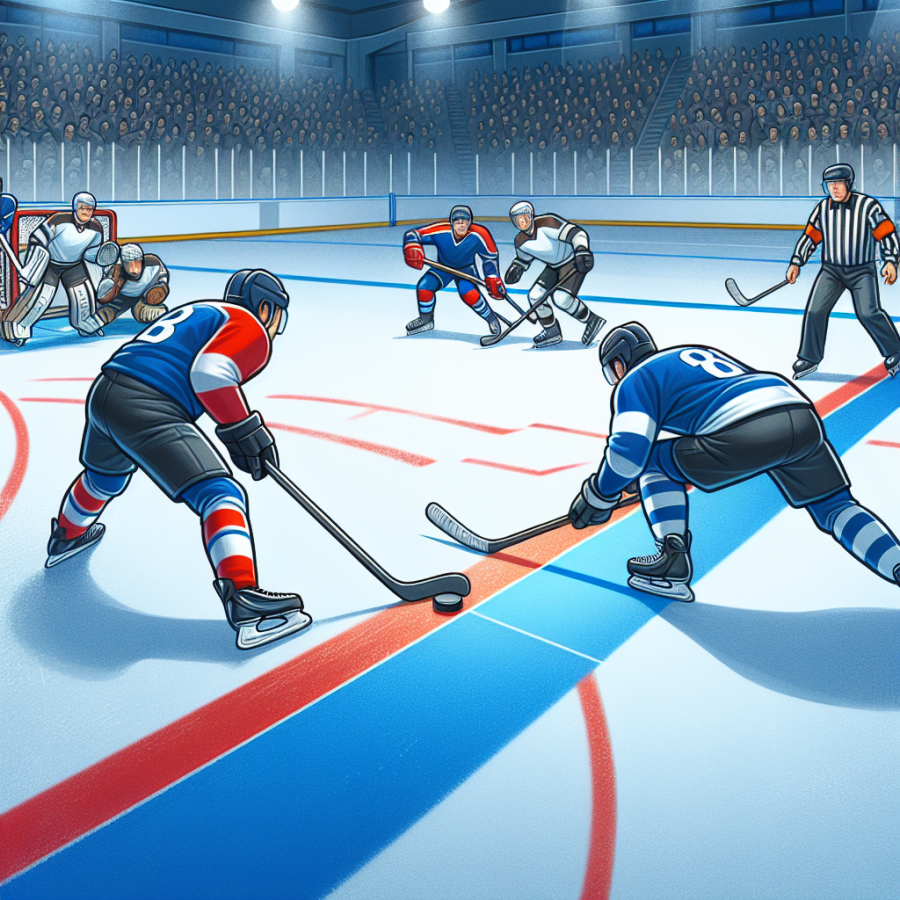Understanding the Basics of the Offside Rule in Ice Hockey
In ice hockey, understanding the offside rule is essential for both players and fans alike as it is a fundamental aspect of the game. The offside rule in ice hockey is relatively straightforward, yet it is critical for maintaining fair play and an even playing field.
The offside rule is designed to prevent players from 'cherry-picking' or waiting near the opposing team's goal for a breakout pass without engaging in the neutral zone play. According to the offside rule, a player is considered to be offside when both of their skates completely cross the attacking blue line into the offensive zone before the puck itself crosses that line.
It is important to note that a player is onside if they have one skate touching or hovering above the blue line at the moment the puck completely crosses it. For a moment, it may appear as though a player is offside, yet they may legally bring themselves onside by pulling the skate back over the blue line before the puck enters the offensive zone. However, if the puck leaves the offensive zone, the players must clear the zone by bringing themselves and the puck back into the neutral zone before attempting another attack.
There is also a concept known as 'delayed offside,' which allows play to continue without a stoppage as long as all players of the offending team clear the offensive zone promptly. If they fail to clear the zone in time, play is then stopped and a face-off is conducted in the neutral zone. This rule is intended to keep the game flowing while still adhering to the offside regulations.
Furthermore, in certain situations, the offside rule is waived, such as when the puck is sent into the offensive zone by the defending team. In this case, attacking players may enter the offensive zone without waiting for the puck to cross the blue line first.
It's crucial for players to develop a keen sense of timing and positional awareness to effectively navigate and exploit the offside rule. As for fans, gaining a solid understanding of offside helps deepen their appreciation of player strategies and the intricacies involved in developing offensive plays.
In summary, the offside rule in ice hockey is a key factor in ensuring that the game is played in a fair and strategic manner. By preventing players from gaining an undue advantage by positioning themselves too far ahead of the play, the rule emphasizes skillful playmaking and teamwork.
Read also:
Decoding the Rules: Maximum Number of Golf Clubs You Can Have
Understanding the Offside Rule
One of the fundamental rules in ice hockey that often confuses beginners is the offside rule. At its core, this rule is designed to prevent players from getting an unfair advantage by waiting for the puck in the offensive zone ahead of play. To dissect this rule, we must first understand the playing area's delineation.
The Ice Hockey Rink Layout
An ice hockey rink is divided into three zones: the defensive zone, the neutral zone, and the offensive zone. These zones are separated by blue lines. The offensive zone for a team is the area where their opponent’s goal is located, while the defensive zone is where their own goal is located.
Breaking Down the Offside Rule
A player is considered offside if they enter the offensive zone before the puck crosses the blue line into that zone. Essentially, the puck must always precede the attacking players into the offensive zone.
The Role of the Linesman
Linesmen are the officials responsible for monitoring and calling offsides. They watch the blue line closely as play approaches to ensure the attacking players are not offside.
The Consequences of an Offside Violation
When an offside violation occurs, play is stopped, and a face-off is held in the neutral zone. This reset provides the defending team an opportunity to regroup and prevents the attacking team from gaining an unfair position closer to the goal.
Delayed Offside
A delayed offside call occurs when a player is in an offside position, but the linesman has not yet stopped play because the offending team has not touched the puck. If the offending team's players clear the offensive zone by tagging up at the blue line, they can nullify the offside and continue play.
Tag-Up Offside Rule
A more recent adaptation in the rules, tag-up offside, allows for continuous play provided all players of the offending team who were in the offensive zone at the time of the offside return to the neutral zone to "tag-up" with the blue line.
Understanding "Onside" Play
Conversely, a player is "onside" if they enter the offensive zone after the puck or simultaneously with the puck crossing the blue line. Players can also carry or pass the puck into the offensive zone without being offside.
Strategies Involving the Offside Rule
Teams use the offside rule to their advantage by developing strategies to force opponents into offside positions.
Navigating the Nuances: A Closer Look at Offside Situations
The offside rule in ice hockey can often lead to confusion due to its dynamic nature and the fast pace of the game. We're going to delve deeper into some nuanced scenarios that can occur in relation to the offside rule to help fans, players, and enthusiasts gain a clearer understanding of what constitutes an offside situation in the game.
To set the stage, let's briefly review the basic offside rule. A player is considered offside if they enter the offensive zone before the puck, unless they have control of the puck. Now, let's explore some nuanced offside situations:
**Delayed Offside**: A delayed offside occurs when a player from the attacking team has entered the offensive zone before the puck but has not touched it. Play will be allowed to continue if all attacking players clear the offensive zone by touching up at the blue line. The linesman raises their arm to signal a delayed offside, and if the defending team takes possession of the puck and goes on the attack, the linesman will lower their arm, and play continues without a stoppage.
**The Tag-Up Rule**: This rule allows players on the attacking team to nullify an offside by 'tagging up' with the blue line. In essence, if an attacking player enters the offensive zone ahead of the puck, they can exit the zone back to the neutral zone and re-enter after the puck has crossed the blue line. This rule promotes continuous play and reduces the number of stoppages for offside infractions.
**Offside Pass or Two-Line Pass**: Prior to the 2004-2005 NHL season lockout, players were not allowed to pass the puck across two lines, such as from the defensive zone past the center line to a teammate. This rule was abolished to increase the flow of the game. It means that while players can now pass the puck from behind their own blue line to a teammate across the center red line without an offside being called, the receiving player must still be onside when they receive the puck.
**Video Review & Coach’s Challenge**: In modern hockey, especially in the NHL, close offside calls can be examined using video review. A coach can issue a challenge if they believe an offside took place prior to a goal. However, if the challenge fails, the challenging team may be penalized, adding a strategic element to the decision to request a video review.




